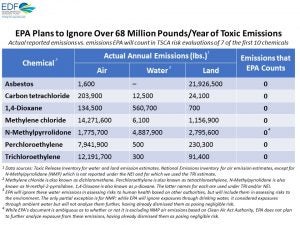Richard Denison, Ph.D., is a Lead Senior Scientist. Stephanie Schwarz, J.D., is a Legal Fellow.
Yesterday EDF filed extensive comments on the Environmental Protection Agency’s (EPA) proposal for the last of the so-called “framework rules” called for under the 2016 amendments to the Toxic Substances Control Act (TSCA). This rule, once finalized, will establish the “user fees” Congress authorized EPA to collect from chemical manufacturers and processors to help defray EPA’s costs for implementing TSCA.
The 2016 Lautenberg Act amendments to TSCA greatly expanded both EPA authorities and responsibilities under TSCA. These extended to chemical testing; conducting risk reviews of new chemicals and prioritizing and conducting risk evaluations of existing chemicals; managing potential or identified risks of both new and existing chemicals; collecting, reviewing and providing access to chemical information; and reviewing confidential business information (CBI) claims asserted by companies when submitting information to EPA.
To determine the level of user fees, EPA is first required to determine its full costs to exercise these authorities and carry out these responsibilities. Fees are then to be set so as to recoup 25% of those costs or $25 million annually, whichever is lower. Separate fees are to be collected to cover EPA’s costs to conduct risk evaluations of chemicals companies request, apart from risk evaluations EPA initiates.
So it is vital that EPA fully and as accurately as possible account for its costs, and that it set fees that meet the intent and letter of the law.
Unfortunately, EPA’s proposed rule falls far short of the mark. EPA has severely underestimated its baseline program costs, both by omitting costs for some relevant activities altogether and by understating the extent or actual cost of other activities. In some cases EPA set fees at a low level based only on industry’s request that it do so or by invoking factors that are not consistent with the law. In the proposal and supporting documents, EPA has provided scant detail or conflicting information on how it calculated many of its costs, making it difficult or impossible for stakeholders to know whether EPA’s estimates are at all accurate.
As a result of these flaws, EPA has set some fees at levels below those required by TSCA and the resulting funds will not be sufficient to recoup the costs TSCA authorized EPA to defray through user fees.
This post will highlight some of the many concerns and questions we discuss in detail in the comments we have submitted. Read More »










